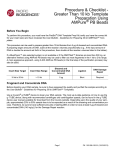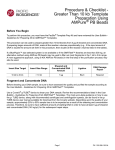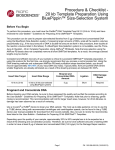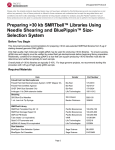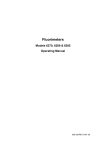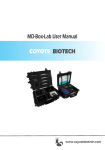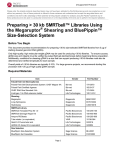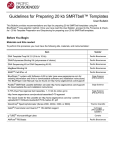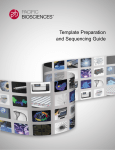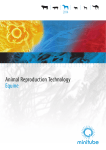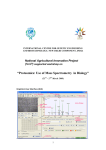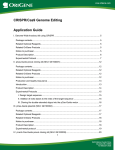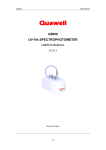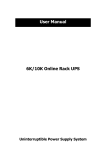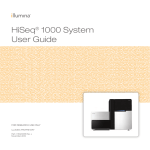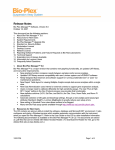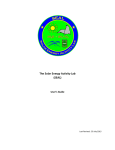Download Recommended DNA Isolation Kits
Transcript
Template Preparation and Sequencing Guide For Research Use Only. Not for use in diagnostic procedures. P/N 000-710-821-13 © Copyright 2010 - 2014, Pacific Biosciences of California, Inc. All rights reserved. Information in this document is subject to change without notice. Pacific Biosciences assumes no responsibility for any errors or omissions in this document. PACIFIC BIOSCIENCES DISCLAIMS ALL WARRANTIES WITH RESPECT TO THIS DOCUMENT, EXPRESS, STATUTORY, IMPLIED OR OTHERWISE, INCLUDING, BUT NOT LIMITED TO, ANY WARRANTIES OF MERCHANTABILITY, SATISFACTORY QUALITY, NONINFRINGEMENT OR FITNESS FOR A PARTICULAR PURPOSE. IN NO EVENT SHALL PACIFIC BIOSCIENCES BE LIABLE, WHETHER IN CONTRACT, TORT, WARRANTY, PURSUANT TO ANY STATUTE, OR ON ANY OTHER BASIS FOR SPECIAL, CONSEQUENTIAL, INCIDENTAL, EXEMPLARY OR INDIRECT DAMAGES IN CONNECTION WITH (OR ARISING FROM) THIS DOCUMENT, WHETHER OR NOT FORESEEABLE AND WHETHER OR NOT PACIFIC BIOSCIENCES IS ADVISED OF THE POSSIBILITY OF SUCH DAMAGES. Certain notices, terms, conditions and/or use restrictions may pertain to your use of Pacific Biosciences products and/or third party products. Please refer to the applicable Pacific Biosciences Terms and Conditions of Sale and to the applicable license terms at http://www.pacificbiosciences.com/licenses.html. Trademarks: Pacific Biosciences, the Pacific Biosciences logo, PacB io, SMRT, SMRTbell, and Iso-Seq are trademarks of Pacific Biosciences in the United States and/or certain other countries. All other trademarks are the sole property of their respective owners. Pacific Biosciences of California, Inc. 1380 Willow Road Menlo Park, CA 94025 www.pacificbiosciences.com Notice of Equipment Class (Korea) For Class A For Class B B EFORE Y OU B EGIN Page 1 Overview Trained Personnel The PacBio® System includes the Instrument, the accompanying kits needed for DNA template preparation and sequencing on the instrument, and the software used to set up runs and analyze data. Any personnel carrying out the procedures described herein must be trained in proper and safe laboratory practices. Throughout Pacific Biosciences® documentation, the words “you” or “user” refer to and assume properly trained individuals. Throughout this guide, user attention words and symbols appear that may require a particular level of awareness or action. User Attention Words and Symbols Note: Calls attention to an item that may be of interest but is not critical to the process. Important: Calls attention to an item that is necessary for proper operation of a step. WARNING! Indicates you should proceed with appropriate caution. Template Preparation Protocols This guide describes an optimized procedure for preparing your DNA template for sequencing on the PacBio System. This Blunt-End Ligation protocol, is suitable for all libraries (greater than 250 bp amplicons) and offers a total preparation time of approximately four hours. SMRTbell™ Templates A SMRTbell™ template is a double-stranded DNA template capped by hairpin loops at both ends. The SMRTbell template is structurally linear and topologically circular. Some advantages of the SMRTbell structure include the generation of both sense and antisense sequence from a single molecule and the ability to achieve high single-molecule accuracy through circular consensus sequencing approaches. By avoiding the use of intramolecular ligation, this method of forming circular templates is similarly efficient across a wide range of insert sizes. This allows a single methodology to support all applications. Page 2 In addition to generating circular templates, the hairpin adapters provide two additional benefits. First, they provide a universal primer binding site and initiation sequence. Second, they protect the ends of the DNA fragments. Exonucleases can therefore be used to degrade failed ligation products and templates containing internal nicks, leaving behind only those templates that are suitable for single molecule sequencing. Template Preparation Process The SMRTbell template preparation method creates a circularized template for use with multiple sequencing protocols. A single streamlined protocol is used to create different insert size libraries by altering the fragmentation conditions. Amplicons can also be used (in the same size ranges as input DNA). This template preparation protocol can be used for all modes of oninstrument sequencing. Template preparation can be complete in 3-6 hours with minimal hands on time. Note that the time requirements scale with the number of samples. The first step in the generation of a SMRTbell library is production of appropriately-sized double-stranded DNA fragments. These fragments can be generated by random shearing of DNA, or by amplification of target regions of interest. The SMRTbell library itself is produced by ligating universal hairpin adapters onto double-stranded DNA fragments. The hairpin dimers formed during this process are removed at the end of the protocol using a magnetic bead purification step with size-selective conditions. Adapter dimers are also efficiently removed using PacBio’s MagBead kit. The final step of the protocol is to remove failed ligation products through the use of exonucleases. Figure 1 Double-stranded DNA Figure 2 Fragmented DNA Page 3 Figure 3 Repaired Ends of Fragmented DNA Figure 4 SMRTbell Adapters 5’ – pATCTCTCTCTTTTCCTCCTCCTCCGTTGTTGTTGTTGAGAGAGAT – 3’ Figure 5 Blunt Adapter 5’-AAAAAAAAAAAAAAAAAATTAACGGAGGAGGAGGA-3’ Figure 6 C2 Primer (underlined sequence hybridizes to the hairpin loop and red portion contains 2’-methoxy modifications to increase stability) After the exonuclease and AMPure PB purification steps, sequencing primer is annealed to the SMRTbell templates, followed by binding of the sequence polymerase to the annealed templates. Finally, the sample is sequenced on the PacBio System. Page 4 DNA Quality Pacific Biosciences’ template preparation process does not use amplification techniques. As a result, input DNA quality will be directly reflected in sequencing results. Any DNA damage (e.g., abasic sites, nicks, interstrand crosslinks) or contaminants (e.g., single-stranded DNA, RNA, proteins, dyes, or salts) present in the input material will impair performance of the system. Therefore, ensure that your DNA sample: • Is double-stranded. Single-stranded DNA will not be made into a SMRTbell template in this template preparation process and can interfere with quantitation and polymerase binding • Has undergone a minimum of freeze-thaw cycles • Has not been exposed to high temperatures (> 65ºC for 1 hour can cause a detectable decrease in sequence quality) • Has not been exposed to pH extremes (< 6 or > 9) • Has an OD260/280 ratio of approximately 1.8 to 2.0 • Does not contain insoluble material • Does not contain RNA • Has not been exposed to intercalating fluorescent dyes or ultraviolet radiation • Does not contain chelating agents (e.g., EDTA), divalent metal cations (e.g., Mg2+), denaturants (e.g., guanidinium salts, phenol), or detergents (e.g., SDS, Triton-X100, CTAB) • Does not contain carryover contamination from the starting organism/tissue (e.g., heme, humic acid, polyphenols) Assaying the Quality of your Sample Prior to fragmentation, we recommend one or more of the following quality assessments to ensure that the DNA is pure and of high molecular weight. Quantitative Assessment • Spectrophotometry (NanoDrop® Spectrophotometer): For samples of concentration > 10-20ng/µL. We recommend an OD260/280 ratio of approximately 1.8 to 2.0 • Fluorimetry: PicoGreen® or Qubit® Fluorimeter Qualitative Assessment • Gel electrophoresis and densitometry compared to the appropriate size standards • Sample DNA should be of high molecular weight and comparable in intensity to a similar mass of control DNA. Page 5 Gel Smear • A Field-Inversion Gel Electrophoresis system can be used to evaluate the quality of gDNA and determine the sizes of sheared DNA and SMRTbell templates (see figure below). On a fieldinversion gel, high-quality gDNA should migrate as a single band of approximately 50 kb (Lane 1). Assaying high-molecular weight DNA is critically important for constructing large insert libraries (e.g. 20 kb libraries). Figure 7 DNA Input Requirements Sizes of Sheared DNA The 10 kb procedure described in this guide has been optimized to produce a 10 kb SMRTbell library with an input amount of 5 µg. For all other insert sizes, download the Procedures from the Customer Portal or www.smrtcommunity.com/SampleNet. Note that depending upon the quality of your sample, approximately 20% sample loss is to be expected as a result of the shearing and concentration process. Therefore, be sure to have sufficient amounts of starting DNA in order to have the required amount of starting material for the DNA Damage Repair reaction. Page 6 Scaling Up Reactions Please note that all reaction volumes are concentration-dependent, and each can be scaled with the input amount of sheared DNA. If preparing larger amounts of DNA, scale all the reaction volumes proportionally. For example, if the input amount is double the amount of DNA, we recommend carrying out the reaction with double of every component and double the total volume. PacBio® Kits and SMRT® Cells Required PacBio Kits and SMRT Cell 8Pacs for Sequencing Experiments on the PacBio System Item Specific Lab Equipment and Related Consumables Required Source Template Prep Kit Pacific Biosciences DNA/Polymerase Binding Kit Pacific Biosciences DNA Sequencing Kit Pacific Biosciences DNA Internal Control Complex Pacific Biosciences MagBead Kit Pacific Biosciences MagBead Buffer Kit Pacific Biosciences AMPure® PB Kit Pacific Biosciences SMRT Cell 8Pac Pacific Biosciences SMRT Cell Oil Pacific Biosciences Required Equipment for Successful Template Preparation Item Vendor Shearing Device: • g-TUBE® microcentrifuge tubes Covaris • Covaris® S2 System (1 sample) or Covaris E-Series (96 samples). For Covaris devices: miniTube holders, and clear miniTubes will also be needed and/or • Hydroshear® Shearing Device Hydroshear Bioanalyzer® Instrument Agilent Technologies PN 2100 Agilent® 2100 Bioanalyzer DNA 1000, DNA 7500, DNA 12000 DNA Kits, and/or High Sensitivity DNA Kit Agilent Technologies NanoDrop® Series (2000, 2000c, 3300, 8000) Thermo Scientific or Qubit® Quantitation Platform - Fluorometer (and Quant-iT™ Assay Kits) Page 7 Invitrogen PN Q32857 Item General Lab Supplies Vendor 96-well plates, semi-skirted Bio-Rad HSP9601 Plate Septa Pacific Biosciences Tube Septa Pacific Biosciences AMPure® PB Beads Pacific Biosciences Recommended DNA Isolation Kits Item Axygen® Sealing Film Roller Vendor Axygen PCR-SP-Roller or Septa Roller (Speedball® Roller) Any Major Laboratory Supplier Allegra® 6KR Centrifuge Allegra Microcentrifuge (1000-16000 RCF) Eppendorf PN 5415D Strip-tube Centrifuge VWR PN 37000-700 Magnetic Particle Concentrator Invitrogen 123-21D 0.2 mL PCR tubes (can be used for all reactions) Bio-Rad 0.2 mL flat cap PCR tube (cat# TFI0201) VWR® tube strip with individually attached bubble caps (cat# 82006-634) Molecular BioProducts 0.2 mL PCR tube, flat cap (cat# 3412) Molecular BioProducts 0.2 mL PCR strip tube (cat# 3418) 0.5 mL VWR®/Eppendorf® DNA LoBind tubes (used for all reactions) Eppendorf PN 80077-236 1.5 mL VWR/Eppendorf DNA LoBind tubes (used for all reactions) Eppendorf PN 80077-230 Ethanol (absolute) Sigma-Aldrich ® Vortex-Genie (with plate shaking attachment) VWR Catalog No. 14005-824 Plate centrifuge Any Major Laboratory Supplier Minifuge Any Major Laboratory Supplier Aerosol-resistant filter tips Any Major Laboratory Supplier Molecular Biology Grade H20 Any Major Laboratory Supplier Page 8 Item Sample Isolation kits: • Blood and Cell Culture DNA Maxi Kit • Blood and Cell Culture DNA Midi Kit • Qiagen® Large-Construct Kit • QIAquick® PCR Purification Kit Page 9 Source Qiagen • • • • PN 13362 PN 13343 PN 12462 PN 28104 F RAGMENT DNA Page 10 Shearing DNA Our large insert size protocols have been validated using DNA fragmented with the Covaris® g-TUBE® device. With any system, there will be some variation in the distribution of the sheared fragments. In addition, some DNA will be lost during the shearing process itself. Depending on the quality of your starting material and the selected method of shearing, you may expect to lose 20% of the starting mass of your DNA sample. Shearing DNA Using a Covaris® g-TUBE® Shearing Device (> 5 kb Insert Sizes) The most up-to-date guidance on how to use the g-TUBE device, along with recommended centrifuges and centrifugation speeds, can be found in the g-TUBE device user manual available for download from the Covaris web site. • After the first centrifuge spin, check the upper chamber for residual liquid. Re-spin if necessary. • If there is still liquid in the chamber after 2 spins, use a 20 µL pipettor and pipette up and down several times. Then spin the tube down again. After shearing, determine the approximate size range by loading 30 ng of DNA on to the Bioanalyzer® 12000 chip or by running a low percent (%) agarose gel. Check quantitation on a Nanodrop system. Note that fragments sheared using the g-TUBE device are greatly dependent on gDNA quality and size and may range from 6 kb to 20 kb. (Optional) Shearing DNA Using a Hydroshear® Shearing Device (10 kb Insert Sizes) A Hydroshear® Shearing Device can also be used to shear DNA samples. However, because Hydrodynamic shearing performance can vary with each shearing assembly, we recommend optimizing the shearing whenever a new shearing assembly is used. The sheared DNA can be stored for up to 24 hours at 4ºC or 2 months at -20ºC. Page 11 Sheared 10 kb DNA Distribution on a Bioanalyzer® Instrument The graph below shows an example of fragment size distribution. Figure 8 Fragment Size Distribution for 10 kb AMPure® PB Purification Steps Throughout this Guide For all 10 kb purification and concentration steps, you must use 0.45X AMPure PB beads. For your convenience, the guide details these requirements in each section. Concentrate DNA Perform the following steps, at room temperature, to concentrate your DNA sample. Note that you must use low-adhesion (LoBind) microcentrifuge tubes during the entire template preparation process. 1. Add 0.45X volume of AMPure PB magnetic beads to the sheared DNA. Before using, mix the bead reagent well until the solution appears homogenous. Pipette the reagent slowly since the bead mixture is viscous and precise volumes are critical to the purification process. Consistent and efficient recovery of your sample is critical to successful SMRTbell library preparation. If using this protocol for the first time, we strongly recommend that you process a control sample first. Using the DNA shearing methods and subsequent AMPure PB bead purification steps described below, you should recover approximately 50% - 80% of your input DNA (by mass). Typical yields from pre-purified DNA (where smaller fragments are already eliminated) are between 80-100%. Page 12 2. Mix the bead/DNA solution thoroughly. Mix the beads with the DNA by pipetting up and down or inverting the tube until the solution is homogenous. 3. Quickly spin down the tube (for 1 second) to collect the beads. 4. Allow the DNA to bind to beads by shaking in a VWR® vortex mixer at 2000 rpm for 10 minutes at room temperature. Note that the bead/DNA mixing is critical to yield. After vortexing, the bead/DNA mixture should appear homogenous. We recommend using a VWR vortex mixer with a foam microtube attachment (see Overview section for part number). If using other instrumentation, ensure that the mixing is equally vigorous. Failure to thoroughly mix the DNA with the bead reagent will result in inefficient DNA binding and reduced sample recoveries. 5. Spin down the tube (for 1 second) to collect beads. 6. Place the tube in a magnetic bead rack until the beads collect to the side of the tube and the solution appears clear. The actual time required to collect the beads to the side depends on the volume of beads added. 7. With the tube still on the magnetic bead rack, slowly pipette off cleared supernatant and save in another tube. Avoid disturbing the bead pellet. If the DNA is not recovered at the end of this procedure, you can add equal volumes of AMPure PB beads to the saved supernatant and repeat the AMPure PB bead purification steps to recover the DNA. 8. Wash beads with freshly prepared 70% ethanol. Note that 70% ethanol is hygroscopic and should be prepared FRESH to achieve optimal results. Also, 70% ethanol should be stored in a tightly capped polypropylene tube for no more than 3 days. a. Do not remove the tube from the magnetic bead rack. b. Use a sufficient volume of 70% ethanol to fill the tube (1.5 mL for 1.5 mL tube or 2 mL for 2 mL tube). Slowly dispense the 70% ethanol against the side of the tube opposite the beads. Let the tube sit for 30 seconds. c. Do not disturb the bead pellet. d. After 30 seconds, pipette and discard the 70% ethanol. Page 13 9. Repeat step 8 above. 10. Remove residual 70% ethanol and dry the bead pellet. a. Remove tube from magnetic bead rack and spin to pellet beads. Both the beads and any residual 70% ethanol will be at the bottom of the tube. b. Place the tube back on magnetic bead rack. c. Pipette off any remaining 70% ethanol. 11. Check for any remaining droplets in the tube. If droplets are present, repeat step 10. 12. Remove the tube from the magnetic bead rack and allow beads to air-dry (with the tube caps open) for 30 to 60 seconds. 13. Calculate appropriate volume of Elution Buffer. a. For 10 kb libraries: __ ng X 0.5 / (__ng/µL) = __µL of Elution Buffer needed The minimum DNA concentration required to proceed to the next step (End-Repair) is 140 ng/µL with preferred mass of at least 5 µg. 14. Add Pacific Biosciences® Elution Buffer volume (calculated in step 13 above) to your beads. a. Thoroughly resuspend beads by vortexing for 1 minute at 2000 rpm. If the beads appear over-dried or cracked, let the Elution Buffer sit on the beads for 2 to 3 minutes then vortex again. b. Spin the tube down to pellet beads, then place the tube back on the magnetic bead rack. c. Perform concentration measurements. Verify your DNA concentration using a Nanodrop or Qubit® quantitation platform. If the DNA concentration is estimated to be equal to or below 12 ng/µL, a Qubit system reading is required. When performing a Qubit system reading, ensure that your sample is within the range of the Qubit kit you are using. For proper concentration calculations, incorporate the dilution factor (used when diluting your sample) to be within range of the Qubit kit and the dilution factor when diluting your sample with the working solution. The latter part of this dilution factor can be calculated automatically by the Qubit system. d. Discard the beads. Page 14 15. Perform qualitative and quantitative analysis using a Bioanalyzer instrument. Note that the Bioanalyzer instrument has different kits in its offering and the appropriate kit, based on insert size, should be used. Dilute the samples appropriately before loading on the Bioanalyzer chip so that the DNA concentration loaded falls well within the detectable minimum and maximum range of the assay. Refer to Agilent Technologies’ guides for specific information on the range of the specific kit you might be using. Note that typical yield, at this point of the process (i.e. postshearing and after one AMPure PB bead purification step), is approximately 50%- 80%. 16. The sheared DNA can be stored for up to 24 hours at 4ºC or at 20ºC for longer duration. Page 15 R EPAIR DNA D AMAGE AND DNA E NDS Page 16 Repair DNA Damage For sheared DNA libraries and PCR products greater than 2 kb, any DNA damage (generated during DNA extraction and PCR amplifications) must be repaired using the DNA Damage Repair reagents provided by Pacific Biosciences. Common types of damage may include abasic sites, cytosine deamination, and oxidation. Note that DNA damage repair is optional for insert sizes less than 2 kb. 1. Thaw the kit components on ice. 2. In a LoBind microcentrifuge tube, add the following reagents: Tube Cap Color Stock Conc. Volume Final Conc. - - 5 µg - 10X 5 µL 1X NAD+ 100 X 0.5 µL 1X ATP Hi 10 mM 5.0 µL 1mM dNTP 10 mM 0.5 µL 0.1 mM for 10 kb Reagent Sheared DNA DNA Damage Repair Buffer 2.0 µL DNA Damage Repair Mix H2O - Total Volume to 50 µL - 50.0 µL - If your input amount deviates from the inputs shown in this table, adjust all reagent volumes proportionately. Note that the DNA final concentration cannot exceed 100 ng/µL. 3. Mix the reaction well by pipetting or flicking the tube. 4. Spin down tube contents with a quick spin in a microfuge. 5. Incubate at 37ºC for 20 minutes, then return reaction to 4ºC until ready for purification. Page 17 Repair Ends The PacBio Template Prep Kit is used to repair the ends of fragmented DNA (or non-phosphorylated 5’ ends of PCR products) in preparation for ligation with hairpin adapters. Note that the tube caps are colorcoded for your convenience. Use the following table to prepare your reaction then purify the DNA. Tube Cap Color Reagent DNA (Damage Repaired) End Repair Mix Stock Conc. − 20 X Total Volume Volume Final Conc. 50 µL − 2.5 µL 1X 52.5 µL − 1. Mix the reaction well by pipetting or flicking the tube. 2. Spin down contents of tube with a quick spin in a microfuge. 3. Incubate at 25ºC for 5 minutes, return the reaction to 4ºC. Purify the DNA Perform the following steps at room temperature. Note that you must use low-adhesion (LoBind) microcentrifuge tubes during the entire template preparation process. 1. Add 0.45X volume of AMPure PB beads to the End-Repair reaction. Before using, mix the bead reagent well until the solution appears homogenous. Pipette the reagent slowly since the bead mixture is viscous and precise volumes are critical to the purification process. 2. Mix the bead/DNA solution thoroughly. Mix the beads with the EndRepair reaction by pipetting up and down or inverting the tube until the solution is homogenous. 3. Quickly spin down the tube (for 1 second) to collect the beads. 4. Allow the DNA to bind to beads by shaking in a VWR® vortex mixer at 2000 rpm for 10 minutes at room temperature. Note that the bead/DNA mixing is critical to yield. After vortexing, the bead/DNA mixture should appear homogenous. We recommend using a VWR vortex mixer with a foam microtube attachment (see Overview section with part number). If using other instrumentation, ensure that the mixing is equally vigorous. Failure to thoroughly mix the DNA with the bead reagent will result in inefficient DNA binding and reduced sample recoveries. Page 18 5. Spin down the tube (1 second) to collect beads. 6. Place the tube in a magnetic bead rack until the beads collect to the side of the tube and the solution appears clear. The actual time required to collect the beads to the side depends on the volume of beads added. Slowly pipette off cleared supernatant and discard. Avoid disturbing the bead pellet. 7. With the tube still on the magnetic bead rack, slowly pipette off cleared supernatant and save in another tube. Avoid disturbing the bead pellet. If the DNA is not recovered at the end of this Procedure, you can add equal volumes of AMPure PB beads to the saved supernatant and repeat the AMPure PB bead purification steps to recover the DNA. 8. Wash beads with freshly prepared 70% ethanol. Note that 70% ethanol is hygroscopic and should be prepared FRESH to achieve optimal results. Also, 70% ethanol should be stored in a tightly capped polypropylene tube for no more than 3 days. a. Do not remove the tube from the magnetic bead rack. b. Use a sufficient volume of 70% ethanol to fill the tube (1.5 mL for 1.5 mL tube or 2 mL for 2 mL tube). Slowly dispense the 70% ethanol against the side of the tube opposite the beads. Let the tube sit for 30 seconds. c. Do not disturb the bead pellet. d. After 30 seconds, pipette and discard the 70% ethanol. 9. Repeat step 8 above. 10. Remove residual 70% ethanol and dry the bead pellet. a. Remove tube from magnetic bead rack and spin to pellet beads. Both the beads and any residual 70% ethanol will be at the bottom of the tube. b. Place the tube back on magnetic bead rack. c. Pipette off any remaining 70% ethanol. 11. Check for any remaining droplets in the tube. If droplets are present, repeat step 10. 12. Remove the tube from the magnetic bead rack and allow beads to air-dry (with the tube caps open) for 30 to 60 seconds. 13. Elute the DNA off the beads. a. Elute the DNA in 30 µL Elution Buffer. Page 19 b. Thoroughly resuspend beads by vortexing for 1 minute at 2000 rpm. If the beads appear over-dried or cracked, let the Elution Buffer sit on the beads for 2 to 3 minutes then vortex again. c. Spin the tube down to pellet beads, then place the tube back on the magnetic bead rack d. Discard beads. 14. Optional: Verify your DNA amount and concentration using Qubit® Nanodrop® or Qubit® quantitation platform, as appropriate. 15. Perform qualitative and quantitative analysis using a Bioanalyzer instrument. Note that the Bioanalyzer instrument has different kits in its offering and the appropriate kit, based on insert size, should be used. Dilute the samples appropriately before loading on the Bioanalyzer chip so that the DNA concentration loaded falls well within the detectable minimum and maximum range of the assay. Refer to Agilent’s users’ guides for specific information on the range of the specific kit you might be using. Note that typical yield at this point of the process (following EndRepair and one AMPure PB bead purification step) is approximately between 80-100% of the total starting material. 16. The end repaired DNA can be stored overnight at 4ºC or at -20ºC for longer duration. Page 20 L IGATE A DAPTERS Page 21 Blunt-End Ligation of SMRTbell™ Templates During this step, blunt hairpins are ligated to repaired fragment ends. Figure 9 Figure 10 Repaired Fragment Ends Blunt Hairpin Adapters and Insert DNA Ready for Ligation To ligate the hairpins (SMRTbell™ templates) to the DNA fragments, you will need BLUNT hairpin adapters. These are shipped as 20 µM oligonucleotide stock and are pre-annealed. This reaction can be scaled for the number of library samples being prepared. Blunt-End Ligation Reaction In a LoBind microcentrifuge tube (on ice), add the following reagents in the order shown (note that you can add water to achieve the desired DNA volume). If preparing a Master Mix, ensure that the adapter is NOT mixed with the ligase prior to introduction of the inserts. Add the adapter to the well with the DNA. All other components, including the ligase, should be added to the Master Mix. Tube Cap Color Reagent DNA (End Repaired) Stock Conc. - Blunt Adapter (20uM) Volume Final Conc. 29µL to 30 µL 20 µM 1.0 µL 0.5 µM 10X 4.0 µL 1X 1 mM 2.0 µL 0.05 mM 1.0 µL 0.75 U/µL Mix before proceeding Template Prep Buffer ATP Lo Mix before proceeding Ligasea 30 U/µL H2O to 40.0 µL Total Volume - - 40 µL a. The Ligase Buffer should remain closed and on ice when not frozen. Page 22 - If your insert size or input amount deviates from this table, you can calculate the amount of annealed blunt adapter to be added to the reaction using the following equation. Be sure to keep a 32.5 fold excess of hairpin adapters and adjust the final volume such that the hairpin adapter concentration does not exceed 1 µM. Total µg of DNA insert X * 106 * 1/650 X 1/Insert size in bp = X picomoles of DNA available for ligation X picomoles of DNA available for ligation X 32.5 = Total excess annealed adapters (Y) Y/20 (20 µM annealed adaptor stock) = Z total µL of annealed adaptor to be added to the reaction If scaling of the reaction volume is necessary, keep the buffer and enzyme concentrations proportional to the recommended amounts shown above. 1. Mix the reaction well by pipetting or flicking the tube. 2. Spin down the tube contents with a quick spin in a microfuge. 3. Incubate at 25ºC for 15 minutes. At this point, the ligation can be extended up to 24 hours or cooled to 4ºC (for storage of up to 24 hours). 4. Incubate at 65ºC for 10 minutes to inactivate the ligase, then return the reaction to 4ºC. You must proceed with adding exonuclease after this step. Add Exonuclease and Incubate Add exonuclease to remove failed ligation products. Tube Cap Color Reagent Stock Conc. Ligated DNA Volume 40 µL ExoIII 100 U/µL 1.0 µL ExoVII 10 U/µL 1.0 µL - 42 µL Total Volume - 1. Spin down the tube contents with a quick spin in a microfuge. 2. Incubate at 37º C for 1 hour, then return the reaction to 4ºC. You must proceed with purification after this step. Page 23 Purify SMRTbell™ Templates In this purification process, there are three (3) distinct and consecutive AMPure PB bead purification steps. The first two (2) steps are performed using 0.45X volumes of AMPure PB beads and the final step can be performed using either 0.40X or 0.45X volumes of AMPure PB beads. Perform all purification steps at room temperature to adequately remove enzymes (exonucleases, ligases, etc.) and ligation products smaller than 0.4 kb (e.g., adapter dimers). AMPure PB Size-Selection and Purification Step #1: 1. Add 0.45X volumes of AMPure PB beads to the exonucleasetreated ligation reaction. Before using, mix the bead reagent well until the solution appears homogenous. Pipette the reagent slowly (since the bead mixture is viscous and precise volumes are critical to the purification process). 2. Mix the bead/DNA solution thoroughly. Mix the beads with the ligation reaction by pipetting up and down or inverting the tube until the solution is homogenous. 3. Quickly spin down the tube (for 1 second) to collect the beads. 4. Allow the DNA to bind to beads by shaking in a VWR® vortex mixer at 2000 rpm for 10 minutes at room temperature. Note that the bead/DNA mixing is critical to yield. After vortexing, the bead/DNA mixture should appear homogenous. We recommend using a VWR vortex mixer with a foam microtube attachment (see Overview section with Catalog part number). If using other instrumentation, ensure that the mixing is equally vigorous. Failure to thoroughly mix the DNA with the bead reagent will result in inefficient DNA binding and reduced sample recoveries. 5. Spin down the tube (for 1 second) to collect beads. 6. Place the tube in a magnetic bead rack until the beads collect to the side of the tube and the solution appears clear. The actual time required to collect the beads to the side depends on the volume of beads added. 7. Slowly pipette off cleared supernatant and save (in another tube). Avoid disturbing the bead pellet. 8. Wash beads with freshly prepared 70% ethanol. Note that 70% ethanol is hygroscopic and should be prepared FRESH to achieve optimal results. Also, 70% ethanol should be stored in a tightly capped polypropylene tube for no more than 3 days. a. Do not remove the tube from the magnetic bead rack. Page 24 b. Use a sufficient volume of 70% ethanol to fill the tube (1.5 mL for 1.5 mL tube or 2 mL for 2 mL tube). Slowly dispense the 70% ethanol against the side of the tube opposite the beads. Let the tube sit for 30 seconds. c. Do not disturb the bead pellet. d. After 30 seconds, pipette and discard the 70% ethanol. 9. Repeat step 8 above. 10. Remove residual 70% ethanol and dry the bead pellet. a. Remove tube from magnetic bead rack and spin to pellet beads. Both the beads and any residual 70% ethanol will be at the bottom of the tube. b. Place the tube back on magnetic bead rack. 11. Check for any remaining droplets in the tube. If droplets are present, repeat step 10. 12. Remove the tube from the magnetic bead rack and allow beads to air-dry (with tube caps open) for 30 to 60 seconds. 13. Elute the DNA off the beads in 50 µL Elution Buffer. Mix until homogenous, then vortex for 1 minute at 2000 rpm. a. Thoroughly resuspend beads by vortexing for 1 minute at 2000 rpm. If the beads appear over-dried or cracked, let the Elution Buffer sit on the beads for 2 to 3 minutes then vortex again. b. Spin the tube down to pellet beads, then place the tube back on the magnetic bead rack c. Discard beads. 14. The eluted DNA, in 50 µL of Elution Buffer, should be taken into the second 0.45X AMPure PB bead purification step. AMPure PB Size-Selection and Purification Step #2: 1. Add 22.5 µL (0.45X volume) of AMPure PB beads to the 50 µL of eluted DNA from the first AMPure PB bead purification step above. Before using, mix the bead reagent well until the solution appears homogenous. Then pipette the reagent slowly (since the bead mixture is viscous and precise volumes are critical to the purification process). 2. Mix the bead/DNA solution thoroughly. Mix the beads with the ligation reaction by pipetting up and down or inverting the tube until the solution is homogenous. 3. Quickly spin down the tube (for 1 second) to collect the beads. Page 25 4. Allow the DNA to bind to beads by shaking in a VWR® vortex mixer at 2000 rpm for 10 minutes at room temperature. Note that the bead/DNA mixing is critical to yield. After vortexing, the bead/DNA mixture should appear homogenous. We recommend using a VWR vortex mixer with a foam microtube attachment (see Overview section with Catalog part number). If using other instrumentation, ensure that the mixing is equally vigorous. Failure to thoroughly mix the DNA with the bead reagent will result in inefficient DNA binding and reduced sample recoveries. 5. Spin down the tube (for 1 second) to collect beads. 6. Place the tube in a magnetic bead rack until the beads collect to the side of the tube and the solution appears clear. The actual time required to collect the beads to the side depends on the volume of beads added. 7. Slowly pipette off cleared supernatant and save (in another tube). Avoid disturbing the bead pellet. 8. Wash beads with freshly prepared 70% ethanol. Note that 70% ethanol is hygroscopic and should be prepared FRESH to achieve optimal results. Also, 70% ethanol should be stored in a tightly capped polypropylene tube for no more than 3 days. – Do not remove the tube from the magnetic bead rack. – Use a sufficient volume of 70% ethanol to fill the tube (1.5 mL for 1.5 mL tube or 2 mL for 2 mL tube). Slowly dispense the 70% ethanol against the side of the tube opposite the beads. Let the tube sit for 30 seconds. – Do not disturb the bead pellet. – After 30 seconds, pipette and discard the 70% ethanol. 9. Repeat step 8 above. 10. Remove residual 70% ethanol and dry the bead pellet. a. Remove tube from magnetic bead rack and spin to pellet beads. Both the beads and any residual 70% ethanol will be at the bottom of the tube. b. Place the tube back on magnetic bead rack. c. Pipette off any remaining 70% ethanol. 11. Check for any remaining droplets in the tube. If droplets are present, repeat step 10. 12. Remove the tube from the magnetic bead rack and allow beads to air-dry (with tube caps open) for 30 to 60 seconds. Page 26 13. Elute the DNA off the beads in 100 µL of Elution Buffer. Vortex for 1 minute at 2000 rpm. 14. Verify your DNA amount and concentration with either a Nanodrop or Qubit quantitation platform reading. If recovery is sufficient to allow for an additional 25% loss in the final AMPure PB purification step (more if the library contains a high number of small fragments), and it is desirable to increase the stringency of size selection, consider using 0.40X volumes of AMPure PB beads. This will remove most fragments <1.5 kb which will dominate loading, if present. Otherwise, proceed to the third 0.45X volumes of AMPure PB bead purification step. Note that yield from 0.40X is typically ~ 10% lower than 0.45X volumes of AMPure PB bead purification. AMPure PB Size-Selection and Purification Step #3: 1. Add 45 µL (0.45X volume) or 40 µL (0.40X volume) of AMPure PB beads to the 100 µL of eluted DNA. Note that for 0.40X volume, it is critical to accurately pipet the desired volume of AMPure PB bead solution; there is a steep drop-off in recovery for concentrations <0.40X. 2. Mix the bead/DNA solution thoroughly. 3. Quickly spin down the tube (for 1 second) to collect the beads. Do not pellet beads. 4. Allow the DNA to bind to beads by shaking in a VWR vortex mixer at 2000 rpm for 10 minutes at room temperature. 5. Spin down the tube (for 1 second) to collect beads. 6. Place the tube in a magnetic bead rack to collect the beads to the side of the tube. 7. Slowly pipette off cleared supernatant and save (in another tube). Avoid disturbing the bead pellet. Note: It is especially important to save the supernatant for 0.40X volumes of AMPure PB purification steps, in case of low recovery 8. Wash beads with freshly prepared 70% ethanol. 9. Repeat step 8 above. 10. Remove residual 70% ethanol and dry the bead pellet. – Remove tube from magnetic bead rack and spin to pellet beads. Both the beads and any residual 70% ethanol will be at the bottom of the tube. – Place the tube back on magnetic bead rack. – Pipette off any remaining 70% ethanol. Page 27 11. Check for any remaining droplets in the tube. If droplets are present, repeat step 10. 12. Remove the tube from the magnetic bead rack and allow beads to air-dry (with tube caps open) for 30 to 60 seconds. 13. Elute the DNA off the beads in 10 µL of Elution Buffer. Vortex for 1 minute at 2000 rpm. 14. Verify your DNA amount and concentration with either a Nanodrop or Qubit quantitation platform reading. For general library yield expect 20% total yield from the Damage Repair input. If your yield concentration is below 12ng/µL, use the Qubit system for quantitation. To estimate your final concentration: (____ ng of DNA going into Damage Repair X 0.2) / ___ of Elution Buffer =____ng/µL 15. Perform qualitative and quantitative analysis using a Bioanalyzer instrument. Note that typical DNA yield, at this point of the process (at the end of library preparation) is between approximately 5-20% of the total starting DNA amount. SMRTbell™ Library Quality Assessment Successful sequencing of a SMRTbell library depends on an understanding of template molarity. This requires accurate quantitation and sizing of the final library. Size distribution can be measured by running 30 ng of the sample using an Agilent Bioanalyzer 12000 chip. Typical library yields will require at least a 1:10 dilution prior to analysis on the Bioanalyzer instrument to ensure reliable quantitation. The SMRTbell library should be quantitated via fluorescence either in single sample (Qubit system) or plate-based (Quant-iT system) formats. Follow all manufacturer’s instructions and ensure that a doublestranded DNA standard is used for the quantitation. Page 28 A NNEAL SMRT BELL ™ T EMPLATES AND P RIMER Page 29 Primer Annealing and Polymerase Binding Prior to sequencing, primer must be annealed to the SMRTbell template, and then DNA polymerase is bound to the annealed templates. Binding Calculator A Binding Calculator is provided to assist with setting up the annealing and binding reactions and setting up the sample plate for sequencing. The Calculator can be used in three different modes: • Volume to use: In this mode, the Calculator uses the entire sample specified to run the maximum number of SMRT Cells possible. • # of SMRT Cells: In this mode, the user specifies how many SMRT Cells to prepare, and the Calculator determines the amount of sample necessary. • Loading Titration: This mode allows the user to set up a loading titration of the bound complex to optimize data yield per SMRT Cell. The Calculator suggests four concentrations around the recommended complex concentration on the sample plate, however, the user can customize the titration range for their sample. After selecting the appropriate mode, enter the following information (note that tool-tips can be found by placing the cursor on each attribute): • Protocol: Select the loading method (MagBead or Diffusion). • Binding Kit: Select the appropriate sequencing polymerase. • Preparation Protocol: Select the library scale used to prepare the sample. • Long Term Storage: Enables options for complexes to be stored (long-term) at -20ºC. • DNA Control Complex: Allows for DNA Internal Control use. • Complex Reuse: For diffusion loading only. The instrument re-uses the sample for a total of up to three uses. • Standard Concentration: Selecting “No” allows sample calculations with volumes and concentrations that do not meet standard requirements. Once the sample details are selected, additional parameters may be modified in the Calculator’s “Custom Parameters” section: • Concentration on Plate: Use the default recommendation as a starting point. Note that this can be modified to maximize yield per SMRT Cell • DNA Control Complex Ratio to Template: Use the default recommendation. This is the percentage of DNA Internal Control to add to the sample. • Polymerase:Template Ratio: Use the default recommendation. For applications which may require a ratio other than the default values, contact your FAS. • Primer:Template Ratio: Use the default recommendation. Page 30 To Access the Calculator You can access the Calculator by downloading it from the web at http://calc.pacb.com or http://calc.PacificBiosciences.com. Be sure to always check for updates. The Calculator is best viewed using Firefox or Chrome browsers. Primer Annealing Overview In this step, sequencing primer is annealed to both ends of the SMRTbell template. Primer annealing requirements vary depending on the library insert size and loading method (e.g. Diffusion or MagBead). For example, SMRTbell templates with an average insert size of 500 bp for diffusion loading require less primer and polymerase compared to a 10 kb library using the MagBead loading method. To achieve efficient loading of SMRTbell templates and to maximize yield per SMRT Cell, PacBio has optimized the ratio of primer to template specific to a library insert size range. Although the ratio can be customized, the recommendation is to use the default settings. See the Pacific Biosciences Binding Calculator Parameters Quick Reference Card for a summary of the recommended primer to template ratio. Reaction Conditions The Primer (5 µM) and 10X Primer Buffer are included in the Template Prep Kit. Before adding the primer to the SMRTbell template, the primer must go through a melting step at 80ºC. This avoids exposing the sample to heat. The template and primer mix can then be incubated at 20ºC for 30 minutes and cooled to 4ºC indefinitely. Primer Sequence The primer is tailed with a poly-A sequence. The poly-A tail is required for MagBead loading but is not required (and does not impact) diffusion loading. 5’-AAAAAAAAAAAAAAAAAATTAACGGAGGAGGAGGA-3’ Page 31 SMRTbell molarity calculation In calculating SMRTbell molarity, we use the following formula: Insert concentration (ng/µl) * 1,000,000 = Insert concentration in Mean insert size (bp) 650 (nM) (or fmol/µL) The detailed calculation is: Insert Concentration (ng/µL) * 1 mol basepairs * 1 g * 1015 fmol = fmol = nM Mean insert size (bp) 650 g 109 ng 1 mol µL base pairs Note that the Binding Calculator can also be used to convert ng/µl to nM and nM to ng/µl. Page 32 B INDING P OLYMERASE TO T EMPLATES Page 33 Binding Reaction Overview In the binding reaction step, DNA sequencing polymerases are bound to the primer-annealed SMRTbell templates. Reaction Conditions The reaction takes place in the presence of a buffer, DTT and nucleotides to stabilize the complex. For polymerase binding, incubation at 30ºC for 30 minutes is sufficient Ratio of Polymerase to Template for Binding The stoichiometric optimum for the polymerase:template ratio is 2 polymerases bound to each template molecule (one to each hairpin adapter). To maximize loading efficiency, binding ratios per library size have been optimized and appear as the default setting in the Binding Calculator. The ratio can be modified in the Optional section of the Calculator, however, it is highly recommended that the default parameters be used. See the Pacific Biosciences Binding Calculator Parameters Quick Reference Card for a summary of the recommended ratios of polymerases to templates for each library. Note that MagBead loading and Diffusion loading require different polymerase to template ratios. Storage of Polymerase-SMRTbell Complexes Once the polymerase-SMRTbell template complex is formed, it should either be immediately used or stored at 4ºC for up to 3 days. Yield may be impacted if stored longer than 7 days. If longer storage time is desired, it is best to store the complex in the Complex Storage Buffer supplied in the Binding Kit. The glycerolbased storage buffer allows the complex to withstand freezing temperature (-20ºC) for more than 30 days, while minimizing the polymerase’s loss of activity. The Binding Calculator provides instructions for preparing complexes for long-term storage. DNA Internal Control Complex: Identity and Amount The DNA Internal Control Complex (available from Pacific Biosciences) provides a means for independent determination of any problems that may occur during binding and the sequencing run. These controls are SMRTbell templates already bound with the polymerase. They are added to the sample before loading on the instrument. See the Pacific Biosciences Binding Calculator Parameters Quick Reference Card for a summary of the DNA Internal Control Complex recommendations. Page 34 The amount of DNA Internal Control Complex to add to experimental templates is determined by the sample insert size and chosen chemistry. The Binding Calculator automatically recommends the amount of DNA Internal Control Complex to add to achieve the total number of reads (between 500-1000 reads per SMRT Cell). Loading Bias Loading of SMRTbell templates into ZMWs is size dependent. Small inserts load better than large inserts. This is particularly important when sequencing different PCR amplicon sizes. It is highly recommended to select amplicons of the same size (+/- 10%) to minimize loading bias. When sequencing large insert libraries (e.g. 20 kb library) for generating long read lengths, it is highly recommended to perform a sizeselection step to eliminate short SMRTbell templates that will preferentially load. The figure below demonstrates loading bias of various insert sizes generated from a 18.5 kb plasmid restriction digest. Figure 11 ZMW Loading Bias for Various Insert Sizes Relative loading (as % of total sequencing ZMWs) versus insert size from a SMRTbell size ladder. A restriction digestion of an 18.5 kb plasmid generated an equimolar distribution of fragments from 160 bp to 4251 bp. The resulting fragments were converted to SMRTbell templates via a modified blunt-end ligation protocol which retains all fragment sizes > 75 bp. The SMRTbell size ladder was sequenced using standard protocols. Page 35 S EQUENCING Page 36 Sequencing Overview Prior to sequencing, the template-polymerase complex must be transferred to a 96-well sample plate with concentrations and volumes specified by the Binding Calculator. This section provides background information for preparing the bound complex for sequencing. Diffusion vs. MagBead Loading Two options are available for loading. The options are dependent on the library size. Library sizes <1 kb must be loaded using diffusion loading. MagBead loading is highly recommended for libraries >1 kb. MagBead Loading During MagBead loading, SMRTbell templates are immobilized to the bottom of the ZMWs by paramagnetic beads. First, SMRTbell templates are captured by MagBeads through a hybridization process between the primer poly-A tail and the oligo dT (on the magnetic bead surfaces). Then the SMRTbell-bound Magbeads are washed thoroughly with MagBead Binding and MagBead Wash Buffers to remove unwanted molecules such as excess primer and polymerases. The washed SMRTbell-MagBead sample is transferred to a 96-well plate, loaded on the instrument and subsequently transferred to a SMRT Cell for immobilization. MagBead loading is enabled by a built-in MagBead station that moves the MagBeads around the surface of the SMRT Cell. Typically, SMRTbell templates greater than 1 kb are immobilized at the bottom of the ZMWs whereas shorter SMRTbell templates, such as adapter dimers, are not. In addition to removal of excess polymerase, primer, adapter dimers and short insert SMRTbell templates, MagBead loading offers the additional advantage of requiring significantly lower sample input amounts. This increases the amount of sequencing data that can be achieved from a sample. MagBead loading is recommended for libraries greater than 1 kb. The Binding Calculator provides concentration recommendations per library size for loading. See the Pacific Biosciences Binding Calculator Parameters Quick Reference Card for a summary of the recommended MagBead loading concentrations. MagBead bound samples are stable for 24 hours. It is highly recommended to use MagBead bound SMRTbell templates immediately following preparation. For more specific information on preparing your library using the MagBead station, see Pacific Biosciences Procedure & Checklist - Preparing MagBeads for Sequencing. The Procedure can be found on our Customer Portal or our website. Page 37 Diffusion Loading Diffusion loading is a method by which SMRTbell templates are immobilized at the bottom of the ZMWs by the process of diffusion. Polymerase-bound SMRTbell templates are diluted with Complex Dilution Buffer, loaded on a 96-well plate and subsequently transferred to a SMRT Cell for diffusion loading. The Complex Dilution Buffer and DTT used for dilution, prior to loading in the instrument, are supplied in the DNA/Polymerase Binding kit. The diluted samples should be used as soon as they are prepared. During a sequencing run, the required diffusion time is 30 minutes for SMRTbell templates up to 3 kb in size and 1 hour for SMRTbell templates greater than 3 kb. Complex Reuse Feature Note that this feature is available for diffusion loading only. The bound complex used for immobilization on one SMRT Cell may be reused on several subsequent SMRT Cells, allowing for greater data output for a given amount of input DNA. When Complex Reuse is selected on the RS Remote, up to two additional SMRT Cells can be immobilized using the diluted complex from the first SMRT Cell (this is limited by both evaporation and the volume recovery capabilities of the instrument). Complex reuse is available for all Standard sequencing insert sizes. It is not available for MagBead loading. Loading Concentration Recommendations The recommended loading concentration on SMRT Cells is dependent on the preferred loading method and library size. When the library size, concentration, volume and required number of SMRT Cells are entered in the Binding Calculator, an optimal on-plate concentration is recommended by default. See the Pacific Biosciences Binding Calculator Parameters Quick Reference Card for a summary of the recommended loading recommendations optimized for library sizes and chemistry. It is highly recommended to perform loading titrations to achieve maximum performance per SMRT Cell. Loading Titration The optimal loading concentration may vary by sample. Slight variations are cumulative in large projects spanning tens or hundreds of SMRT Cells, and a pilot experiment with a loading titration is recommended to maximize overall yields. The data that is generated in the pilot run can be included in any downstream analyses along with larger optimized data sets. The Binding Calculator facilitates setting up the complex dilutions on the sample plate to titrate loading concentrations. The calculator will generate four dilutions around the recommended concentration. The Page 38 user can make these dilutions, from the same bound complex, and run the four samples in a pilot loading titration run. After the run has completed and the data processed, the productivity output of primary analysis can be used to select the optimal concentration for running a larger batch of SMRT Cells. Choose the concentration that yields the most data output at an acceptable accuracy. An underloaded SMRT Cell will generate less data (see Figure 12 below). An overloaded SMRT Cell may result in higher data output but with an impact on raw accuracy and read length due to multiple polymerasetemplate complexes in the same ZMW (see Figure13). Figure 12 Yield (Mapped Reads) with increasing On-SMRT Cell Loading Concentration. On-SMRT Cell concentration is the final concentration of the diluted sample transferred to the SMRT Cell. On-plate concentration is the concentration of the sample in the 96-well plate and which is the value entered in the Binding Calculator. Page 39 Figure 13 Effects of loading to accuracy with increasing On-SMRT Cell Concentration. Overloading affects raw accuracy and read length. Required Sample Well Volumes The sample volume to load in a well of a 96-well sample plate is dependent on the desired number of SMRT Cells, loading concentration and loading method. See the Pacific Biosciences Binding Calculator Parameters Quick Reference Card for a summary of required sample well volumes. During a run, the automated pipettor takes an aliquot of the sample for dilution before delivering it to a SMRT Cell for immobilization. To ensure accurate pipetting, the pipettor requires dead volumes of 5 µL for diffusion loading and 10 µL in the sample plate for MagBead loading. The dead volumes are factored in the required volumes in the Pacific Biosciences Binding Calculator Parameters Quick Reference Card. Prepare Your Reagent Plates Thaw the following kit components accordingly: Page 40 1. OS Enzyme: Remove the OS Enzyme from the reagent package. Keep at -20 ºC at all times. When ready to use, spin down the tube for 5 seconds, replace cap with tube septa, and place on the reagent drawer of the instrument. 2. Reagent plate: The reagent plate can be thawed overnight at 4ºC. Thaw an additional 15 minutes, at room temperature, before using. Note the following precautions which may impact reagent performance: • Do not thaw in hot water. • Do not remove plate seal until it is ready to be placed on instrument. • Do not keep at room temperature after thawing. • Do not keep the unsealed plate exposed to air. Place the septa mat on plate immediately. 3. Place the reagent plate on a VWR Microplate Shaker and shake for 1 minute at 1200 rpm. 4. If precipitates are present in any of the filled wells, mix thoroughly by vigorously vortexing until the solution is clear. 5. Spin the plate in a centrifuge briefly at 2000 rpm. 6. Peel the foil seal off the plate as shown: 7. Place the supplied Septa mat on the plate. 8. Using a roller, further press down the Septa mat onto the plate. Prepare Your Sample Plate Dilute Your Bound Complex Load your samples on to a Sample plate. Place the white Septa mat on the plate and press down with a roller to ensure a tight fit: – Spin your sample plate down for 30 seconds at 2000rpm – Place on the instrument Load Your Reagent, Mixing and Sample Plates At the instrument, open the Reagents/Samples drawer. You can either press the illuminated Open button on the instrument Reagents/Samples drawer or the Open button on the touchscreen User Interface. Page 41 Load your Reagents on to the Instrument: 1. When the drawer opens, lift up the metal door covering the Reagents slots. Lift Lift here 2. Place your reagent plate in the Reagent slot. Note that there are 2 slots, if you have only one plate, you can place it in either slot. The Barcode Scanner will locate the plate. 3. Remove the OS Enzyme from the refrigerator or ice. 4. Replace the cap with a tube septa. Be careful not to remove the barcode collar, the Machine Vision System will read the barcode. Page 42 5. Place the tube in the left slot encircled by your reagent plate location. 6. Remove the blue cap from the SMRT Cell Oil tube. 7. Replace the cap with a tube septa. Place the SMRT Cell Oil tube in the right hand reagent slot. Note that the SMRT Cell Oil tube is slightly larger and will fit only in that slot. OS Enzyme tube location SMRT Cell Oil tube location 8. Gently close the metal door. Load your samples and mixing plate on to the Instrument: 9. Lift up the metal door covering the Sample and Mixing slots. Lift here Page 43 10. Place your sample plate in the slot labelled Sample. 11. Place a 384-well mixing plate (Eppendorf LoBind Deepwell plates) in the slot labeled Mixing. 12. Gently close the metal door. 13. Press the Close button on the touchscreen User Interface (optionally, press the Close button on the instrument). Load the SMRT® Cells and Tips Open the SMRT Cells/Tips drawer. You can either press the illuminated Open button on the instrument SMRT Cells/Tips drawer or the Open button on the touchscreen User Interface. Load your SMRT Cells/Tips on to the Instrument: Page 44 1. When the drawer opens, place the appropriate number of SMRT Cell 8Pacs (determined previously during project planning) into the SMRT Cells tray. Place this end in first 2. Place tip boxes in the slots. Be sure to remove the lid and tape from the tip boxes. 3. Gently close the drawer door. 4. Press the Close button on the touchscreen User Interface (optionally, press the Close button on the instrument). Page 45 WARNING! Pinch Point. Do not place fingers inside drawers as they are closing. Start Your Run Before starting your run, press Scan (on the RS touch screen) in order for the instrument to scan the contents of the drawers. Once the contents have been scanned, the Start button will be enabled. After pressing Start, the UI will prompt you to verify that certain steps have been performed prior to sequencing: – Waste has been emptied. Verify that the Waste bin is less than half full. – Nitrogen supply is within range. Locate your facility's N2 tank supply gauge and verify that the supply is > 80 psi (preferably > 100 ~ 120 psi). Refer to the RS Remote online help systems for more information. Page 46 T ROUBLESHOOTING Troubleshooting Low Library Yields When Adapter Dimers May Be Cause of Low Yield If you suspect that the low yield is due to adapter dimers, then you can try re-purifying the library: – Use MagBead loading. – Increase the current annealed template volume to 50 µL using 1X Primer Buffer (dilute the Primer Buffer 1:10 in water). – Then perform an additional AMPure® PB bead purification step using (e.g., for a 10 kb library use 0.45X AMPure PB beads). However, do not shake in a VWR vortex mixer at 2000 rpm (room temperature) for more than 10 minutes as adapter-dimers may bind to the beads. – After the ethanol wash, resuspend the beads in 1X Primer Buffer. – Calculate the appropriate volume of Elution Buffer and elute the DNA off the beads. – Perform an OD260/280 calculation to recalculate molarity before setting up the Annealing and Binding reaction. Then repeat the Primer Annealing steps using the Sample Preparation Calculator (see the Anneal and Binding sections of this Guide). When DNA Quality is Suspected to be Sub-Optimal – Ensure that the concentration of AMPure PB beads is appropriate for the size of the library being prepared. For example, 250 bp libraries should be purified with 1.8X volume of AMPure PB beads; if less than this amount is used then library yield will suffer. – The ends of the DNA insert fragments should not be labeled in order to allow the hairpin adapter -insert DNA ligation reactions to proceed. For instance, 5’FAM labeled PCR products can not be used as the input DNA for making SMRTbell templates. A failure at the ligation step will lead to little or no library after the exonuclease treatment, as partially ligated products are degraded. – The PacBio Template Prep Kit should be properly handled with all reagents and enzymes stored at -20°C. The Template Prep Kit uses a number of different enzymes and improper storage of these enzymes can lead to reductions in their catalytic efficiency and drops in either library recovery or eventual sequencing yield. For example, using inactive ligase will compromise the ligation step and lead to little or no library recovery. Page 47 When the Sheared Library is the Wrong Size – Make sure to optimize shearing conditions. While this guide makes certain recommendations about shearing conditions, it is also important to verify conditions effective for shearing your particular DNA sample on your shearing device. – Verify that the input DNA used for shearing is high molecular weight DNA at the appropriate concentration for your shearing device. If the input DNA is damaged, this can lead to smaller insert sizes and difficulty in generating large insert size libraries. Additionally, the concentration of the input DNA can also alter the shear-size. When Library Yield is High but Sequencing Yield from the Library is Still Low – Properly quantify SMRTbell libraries before annealing sequencing primer. Run a Bioanalyzer gel (from Agilent) following manufacturer’s loading recommendations. Sheared libraries are comprised of a distribution of fragment sizes around a targeted size, and molarities are best approximated using the Bioanalyzer software. – Check the level of adapter dimer contamination. Because of an intrinsic loading bias that favors the immobilization of smaller DNA template sizes in the SMRT Cells, the amount of hairpin dimers in your sample should be kept as low as possible (ideally < 1%; adapter dimer levels approaching 2% or higher will significantly decrease sequencing yields). We strongly encourage performing at least a double-AMPure PB bead purification step prior to performing the primer-template annealing reactions (when automating the library preparation procedure using a robotic platform, a triple purification process may be necessary). Page 48 A PPENDIX Internal Control Complex Sequence TCCTCCTCCTCCGTTGTTGTTGTTGAGAGAGAGAAGCGCTCGCACACCACATCAAGGCTGGTGCGG GGAGCTCCCCCACCCCGGTAACCGCGATTGCCCTCGGGCCGGCCTACACTCCCTTTGCCGGCGTAT ACTTATTTAGCGTCCATGCTAACGCCGGCGCTACGCGTGGGAGAACCGGATCCACAGGCCCCATGGA CCGCACCTGTGTGAGCACAGGCCGCTCTCCGGAAACCAGCGGTCCCTCGTCGCCTGAATGCACCGA CCCCCAACGTTGGCGACCGTCGCGGAGGCAACCCCCGCCACGAACGGGGTGTCCTTCGTGCACGG TTACTCAGGCCCGCAGGGCGTCACGCGATGGTAGTAGCTCACTTCTTTGAATCCGGCCAGCGACGC CGTCTACGTTGGGGCCGAGTCGAGAGCGCACCGCTAATGGCCGGCGCAGTAGCGCTGGCCAGCAC AGGGTACATAGCTGCGATCGACGAAAAGGCCTGGGCGGGGCCACGTCGGCTCGGCCCGGGCGTCC AGGGTTCCCCACAGCGTGAGCCGGCATTGCCCACGGAGACAGCTCGAGAGCAGAGTACGCGAGGC GCAAGGTCGAGTCATCCTTTTGGAGCGGGGGCTGGATCGCAGCCCAGTTGCGGCCGCCGGGGACA GGCTGTAGTCCGGCGAACGGTACCCCTGAGGAGCTTAGACGACTGGCTCGTCCCTGCGTGTTATCA ATAGCTTTACCGCTCCGGTTCTACTATGATTTACCGAAACGTCCGCCAAAAATCTCTGGGGTGCTTACG CATCGAACGTAATACGAACATACTAGGGCGTCCCGCAACTGGTCGAGTAACTTCCCGGCGGATCGTG CCGGAGTCGGCTAAAAGACACCCCCAATTCGTGCGATAAGGTGGCGAGACTAAGATCATATGAAATAC GAGTCGGCCTCCGAACAAGGTCCTTACTTACTGCAGTTATGGTACACACGGGGCTGTGAGAACTCCA TGGCGGAAACTGAGTCACGGAGCATGATAGTGCGTATGGTCAACTAATCATCCGGTAATTATTGTTCTC CAGCTCCGCGGTTCGCGACTATGTGAGTCAAACTTACGAATTGGACCGTATCATCTGGTAGATAACGT CCTTGGACCAGCCGGCAATGTGGCGTAAATCTCGAACGCACGAGTTTCGAACGACACATAACATGCT ACGGGATTGAGTCCCGTGTGTGCGCATCGCCTGACGCCACTTAGTGAAGTCTCCATCCGTCAACAAA CAGCCCCAGACAAGTTTCAGACCATCTGACTACGTGCGCGGCGTGTAGTTTCGAACCCGAGATTACA TGGCTACTATACTCTTGGGTTTCCACTGCAATATACTTTGCGTATAAGTTATTTTTAAGTCATATAGCTTTA CAGCGAAAAGAGAAAGTTTCTAATTTTATCTTTAGATATTTCAAGGATATTCTATCACTATAAAATCGTATT ATCTCTTTTCGCCACTGAAATAAACAGTATTTCATTATTATGAAAATATGATTAAATAAAATTATTTCCAAAT TTCGTAACTTTGTTTTAAAGTTATATAATTTAGGAACTTAGTGTACTATATGTAACTATTGGATCATATTACT TCTAAGTCTTATATTTTAAGTATTATTTTGTTCGCATTCCTTTGGTTATCTTAGTAAAAATGTCTTGAATAA GTATTGTGTGAGATTTAATTAATTAATTTTTAATAATGTCAAGCTATAATCATATGCCAATGTCTTAAATACT TAGTACATAAACTTTTATAATGCAACGTCTAAGCATCCTTATAAGTTTAATTCCAATTCTATATAACACAAC ATCAAATTAAATACCGTGAGTAAAATTATTGAACAATTAATGGACATGGCAAAAAATAAATGATATGCCTG TGTCCGCGTGTATAGCAAGCATAATGCATACAGGTGTGCAGGGATTACTTTAGATAAGTTATATGTCAAA GCTACGTTGAGATGACCTAGACACGGGTCTCTCTCTTTTCCTCCTCCTCCGTTGTTGTTGTTGAGAGA GACCCGTGTCTAGGTCATCTCAACGTAGCTTTGACATATAACTTATCTAAAGTAATCCCTGCACACCTG TATGCATTATGCTTGCTATACACGCGGACACAGGCATATCATTTATTTTTTGCCATGTCCATTAATTGTTC AATAATTTTACTCACGGTATTTAATTTGATGTTGTGTTATATAGAATTGGAATTAAACTTATAAGGATGCTT AGACGTTGCATTATAAAAGTTTATGTACTAAGTATTTAAGACATTGGCATATGATTATAGCTTGACATTATT AAAAATTAATTAATTAAATCTCACACAATACTTATTCAAGACATTTTTACTAAGATAACCAAAGGAATGCG AACAAAATAATACTTAAAATATAAGACTTAGAAGTAATATGATCCAATAGTTACATATAGTACACTAAGTTC CTAAATTATATAACTTTAAAACAAAGTTACGAAATTTGGAAATAATTTTATTTAATCATATTTTCATAATAATG AAATACTGTTTATTTCAGTGGCGAAAAGAGATAATACGATTTTATAGTGATAGAATATCCTTGAAATATCTA AAGATAAAATTAGAAACTTTCTCTTTTCGCTGTAAAGCTATATGACTTAAAAATAACTTATACGCAAAGTA TATTGCAGTGGAAACCCAAGAGTATAGTAGCCATGTAATCTCGGGTTCGAAACTACACGCCGCGCACG TAGTCAGATGGTCTGAAACTTGTCTGGGGCTGTTTGTTGACGGATGGAGACTTCACTAAGTGGCGTC AGGCGATGCGCACACACGGGACTCAATCCCGTAGCATGTTATGTGTCGTTCGAAACTCGTGCGTTCG AGATTTACGCCACATTGCCGGCTGGTCCAAGGACGTTATCTACCAGATGATACGGTCCAATTCGTAAG TTTGACTCACATAGTCGCGAACCGCGGAGCTGGAGAACAATAATTACCGGATGATTAGTTGACCATAC GCACTATCATGCTCCGTGACTCAGTTTCCGCCATGGAGTTCTCACAGCCCCGTGTGTACCATAACTGC AGTAAGTAAGGACCTTGTTCGGAGGCCGACTCGTATTTCATATGATCTTAGTCTCGCCACCTTATCGCA CGAATTGGGGGTGTCTTTTAGCCGACTCCGGCACGATCCGCCGGGAAGTTACTCGACCAGTTGCGG GACGCCCTAGTATGTTCGTATTACGTTCGATGCGTAAGCACCCCAGAGATTTTTGGCGGACGTTTCGG TAAATCATAGTAGAACCGGAGCGGTAAAGCTATTGATAACACGCAGGGACGAGCCAGTCGTCTAAGCT CCTCAGGGGTACCGTTCGCCGGACTACAGCCTGTCCCCGGCGGCCGCAACTGGGCTGCGATCCAG Page 49 CCCCCGCTCCAAAAGGATGACTCGACCTTGCGCCTCGCGTACTCTGCTCTCGAGCTGTCTCCGTGG GCAATGCCGGCTCACGCTGTGGGGAACCCTGGACGCCCGGGCCGAGCCGACGTGGCCCCGCCCA GGCCTTTTCGTCGATCGCAGCTATGTACCCTGTGCTGGCCAGCGCTACTGCGCCGGCCATTAGCGGT GCGCTCTCGACTCGGCCCCAACGTAGACGGCGTCGCTGGCCGGATTCAAAGAAGTGAGCTACTACC ATCGCGTGACGCCCTGCGGGCCTGAGTAACCGTGCACGAAGGACACCCCGTTCGTGGCGGGGGTT GCCTCCGCGACGGTCGCCAACGTTGGGGGTCGGTGCATTCAGGCGACGAGGGACCGCTGGTTTCC GGAGAGCGGCCTGTGCTCACACAGGTGCGGTCCATGGGGCCTGTGGATCCGGTTCTCCCACGCGT AGCGCCGGCGTTAGCATGGACGCTAAATAAGTATACGCCGGCAAAGGGAGTGTAGGCCGGCCCGAG GGCAATCGCGGTTACCGGGGTGGGGGAGCTCCCCGCACCAGCCTTGATGTGGTGTGCGAGCGCTT CTCTCTCTCTTT Insert sequence (lowercase, no color) Hairpin stem sequence Hairpin loop sequence (primer binding site in bold/underline) Site of first incorporation Page 50




















































